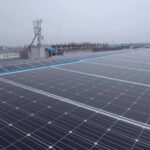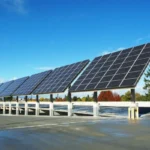India’s Renewable Energy Revolution: The Role of Agrivoltaics
India’s Renewable Energy Revolution: The Role of Agrivoltaics
The International Institute for Sustainable Development (IISD) recently published a report outlining different business models that can help India overcome the challenges of implementing agrivoltaics, a practice where solar panels are installed on agricultural land.
The report suggests three specific models:
- Joint ownership between farmers and developers
- Sole ownership by either party
- Developer-led partnerships with farmers.
Currently, India has around 14,636.6 kW of agrivoltaics capacity in the pilot stages. The report emphasizes the difficulties faced by Indian farmers and developers in adopting agrivoltaics and recommends following the third model, where developers take the lead and farmers become partners. However, this model is only suitable for barren or uncultivated areas due to poor land productivity or state ownership.
Around 53% of India’s land area is classified as arid or semi-arid, and most solar power capacity is installed in such regions with low cropping intensity. These areas, along with peri-urban regions, are favorable for agrivoltaics. However, successful implementation requires proximity to markets for high-value horticultural products.
The report suggests that state governments introduce land-use regulations and define clear standards for agrivoltaics. Different market mechanisms and tariff structures should also be explored to support agrivoltaics.
The use of bifacial solar panels is recommended in Indian agrivoltaic projects as they reduce shading effects, increase power generation, and offer more crop choices.
Integrating rainwater harvesting structures with agrivoltaics is also seen as a promising solution. However, further research and peer learning are necessary due to India’s unique weather conditions. Battery storage is an option for energy storage, but alternative technologies should be considered for farmers who cannot afford it.
Most agrivoltaic pilots in India, initiated under the Pradhan Mantri Kisan Urja Suraksha evam Utthaan Mahabhiyan (PM-KUSUM) program, have not yet grown mainstream crops like paddy and wheat. Proper planning is required to ensure solar panels do not hinder crop production. The report also suggests exploring the option of open access, where developers can directly sell power from agrivoltaic projects to consumers at agreed-upon prices.
Countries like China, Germany, France, and Japan are actively promoting and updating designs and standards for agrivoltaics. They integrate solar panels with different farming systems, such as greenhouses and conventional open farming systems, to adapt to diverse agricultural activities and weather conditions. These countries have a cumulative installed agrivoltaics capacity of approximately 2.5 GW. Italy and France also have significant investments in agrivoltaics.
The report concludes that grid-connected agrivoltaic systems are more scalable than off-grid systems due to higher power production. However, adequate evacuation capacity and proximity to substations are crucial for grid-connected renewable energy to minimize losses. Exploring these aspects in Indian agrivoltaics is an area that requires further exploration.
Suggested Articles

India Solar Energy Policies: Key Updates and Government Initiatives
India is one of the leading countries in terms of solar energy development, having become the fastest-growing market for solar power globally.

Haryana Electricity Tariff Hike Impacts All Consumer Categories in 2015-16
Haryana electricity tariffs were increased across all consumer categories in 2015-16, raising power costs for households, industries, and businesses statewide.

Stop Losing Power: The Ultimate Guide to Solar DC & AC Cable Sizing for Max Efficiency
DC and AC cabling are the lifelines of any Solar PV Rooftop System. Learn how proper cable selection, connection design, and installation can help achieve optimum power output and long-term safety.

500 kW Solar System Price in Indore: Complete Industrial Guide
Planning to install a 500 kW solar power plant in Indore? Discover the complete cost details, government subsidy options, and potential savings for industries in 2025.

How to Safely Install Solar Panels on Metal and Asbestos Rooftops
Discover how solar systems can be installed on metal sheds and asbestos roofs, making factories more energy-efficient and sustainable

CAPEX or OPEX? How to Choose the Best Solar Ownership Model
Choosing between the CAPEX and OPEX models can greatly impact your solar savings and ownership benefits. This guide explains both models to help you make the right decision.

Latest Solar Mounting Structures: Smarter, Stronger, and More Efficient
Learn how the latest solar mounting structures in 2025 improve efficiency, reduce costs, and power the future of solar installations.

Should You Switch to Solar in India? Complete Guide
India has become a hot-selling solar market and people are interested in installing solar systems in their homes as well as in industries and factories.